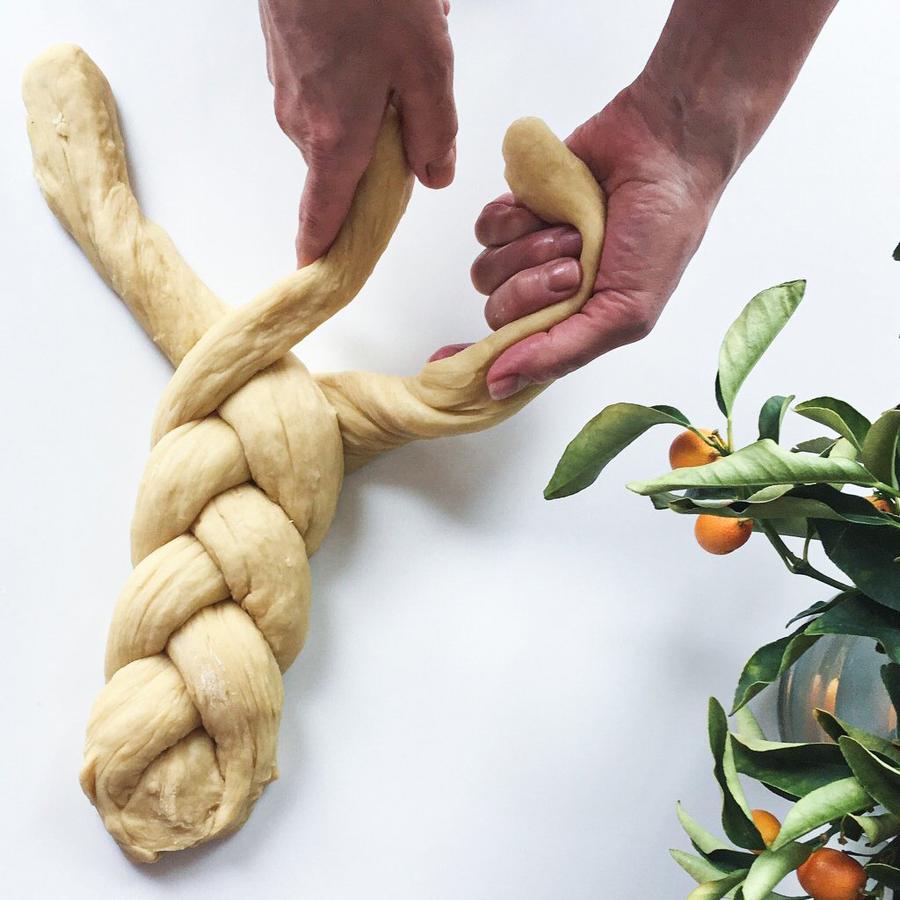CHALLAH BREAD: CHEF TALK and COOKING PROGRAM on Learn to Braid the Best Jewish Brioche AND Homemade Dill Butter
Challah — the iconic braided Jewish brioche — is known worldwide as a traditional sabbath bread prepared by German and Eastern European or Ashkenazi Jews. But how did challah become synonymous with Jewish culture and cooking traditions around the world?
The plural Hebrew word challot (חַלּ֑וֹת) is mentioned in the Bible when the Israelites are commanded to prepare 12 loaves or cakes (representing the 12 tribes of Israel) and place them in the desert tabernacle for Shabbat. Once settled in the Land of Israel, the Israelites are instructed to set aside a small portion of kneaded dough (challah / חַלָּה) for the priests (kohanim) of the Holy Temple in Jerusalem. After the First and Second Temples were destroyed the ritual of burning a small piece of dough or baked bread began as a way of commemorating the gift that was reserved for the kohanim when the Holy Temples once stood. Although the original style and shape of these sabbath breads were flat and often round in the Middle East, a sweeter and more cake-like bread made with eggs was adopted centuries later in the West, turning into the popular braided challah version we know today.
Over time the challah bread has evolved into different shapes and sizes, incorporating all kinds of fillings and decorations. The interwoven braided strands have come to symbolize love, unity, and connectedness, while the poppy and sesame seeds sprinkled on top represent the manna that fell from heaven and sustained the Israelites during their long trek through the desert. During the Jewish new year of Rosh Hashanah, round loaves sweetened with honey and raisins are prepared for good luck, while in recent years food coloring has been incorporated to create a braided rainbow that recalls God’s covenant with Noah after the big flood.
This interactive seminar will demonstrate how to make this cherished traditional bread as well as an easy homemade butter with dill and za’tar to spread on your freshly baked bread. Participants will come away with an increased understanding of what challah is, and the creative ways in which to prepare it at home. Whether you are a novice and have always wanted to learn how to make homemade bread, or more advanced and simply looking for new and creative ways to improve your technique, this lesson is for you. You don’t have to be Jewish — or observe Shabbat — to make neighbors jealous of that freshly-baked bread smell wafting from your kitchen. (And honestly, what’s more delicious than freshly baked bread right out of the oven, spread with homemade butter?)
Please note: Because challah requires a period of several hours to rise, I will be showing how to prepare a basic challah dough during class, and then demonstrate how to shape two kinds of challah breads with dough I have prepped ahead of the lesson: one traditional 3-strand braid and one spiral shaped stuffed with raisins. Students will receive a recipe packet explaining how to braid using 3, 4, and 6 strands as well as how to use a standard loaf pan or create a spiral shaped round loaf.
GENERAL INGREDIENTS:
All-purpose unbleached flour OR: whole wheat flour + all-purpose unbleached flour
Salt (kosher preferred)
ACTIVE dry yeast
Ground flax seeds (for whole wheat version; optional)
Vegetable or canola oil
Honey
Eggs
Sesame and/or poppy seeds for sprinkling on top (optional but suggested)
Raisins (black, yellow, or mixed), if preparing sweet/Rosh Hashanah version (optional)
Mix of sugar and ground cinnamon, if preparing sweet/Rosh Hashanah version (optional)
Heavy cream
Fresh dill and/or chives
Za’tar spice blend
Extra virgin olive oil and Coarse sea salt, for sprinkling on top (optional)
EQUIPMENT:
Measuring cups and spoons
Kitchen scale, for weighing flour (optional but preferable)
Large mixing bowl and spoon (for mixing dough)
Large mixing bowl (need 1 for each dough that needs to rise)
Plastic wrap or light kitchen towel, for covering rising dough
Large baking tray or half sheet pan, for baking 1 or 2 standard challah breads
Standard bread loaf pan (if baking in loaf style)
8- or 9-inch round baking pan (if forming and baking dough into round shape)
Parchment paper or silicone baking pad, for lining baking trays/pans (optional but highly recommended)
Small bowl, for making egg glaze
Pastry brush, for brushing unbaked breads with glaze
Pastry Scraper (optional but recommended for easily picking up/cleaning dough from bowl and counter)
Food processor, for making butter
Medium bowl, for mixing butter ingredients
Clean kitchen towel or large pieces of cheesecloth, for preparing butter
Rubber spatula, for making butter
1½- to 2-cup size air-tight glass, ceramic, or plastic container, to store butter

